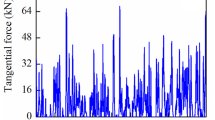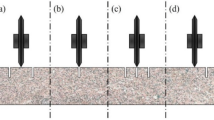Abstract
Evaluation of optimum rock cutting performance is very important, especially at the phase of the design of a tunneling machine. In this regard, existing theoretical, laboratory, numerical, or empirical methods focus only on the optimum ratio of cutter spacing over penetration, and they need further enhancements to include various design aspects of the TBM cutterhead with respect to cut and cutter geometry parameters as well as its major layout design characteristics. Field data analysis is regarded as the most accurate and reliable method in the industry as it covers various geological conditions (which is not as easy in the laboratory or numerical simulations), and it provides new practical formulas to evaluate TBM performance. To investigate the influence of various parameters on the cutter penetration and to provide a basic guideline to optimize field cutter spacing and cutterhead layout design, an extensive field database is compiled. With the use of this database, the effects of rock type and uniaxial compressive strength on cutter penetration are investigated in various categories of cutter spacing. Major layout designs of the cutterheads utilized in various rock types and different categories of tunnel sizes are investigated for projects with relatively high performance. The results of the conducted analyses show that the maximum cutter penetration in uniaxial compressive strength values below 50 and above 150 MPa is achieved close to 90 and below 80 mm, respectively. The results of the study on the layout design characteristics of the cutterhead indicate that the evenly distributed scheme is more used with success even in softer rocks (when the rock mass condition is good). In softer rocks, the extension of the openings has to be well over 50% of the cutterhead radius to maximize its performance. In this regard, some empirical formulas are generated through statistical analysis of the data from around 300 tunnel projects to evaluate both optimum cutter spacing and optimum ratio of cutter spacing over penetration. New formulas are also provided to evaluate cutterhead thrust, torque, RPM, and power. In the end, based on the discussed issues, to optimize cutter penetration and TBM cutterhead overall performance, some procedural steps are offered.

















Similar content being viewed by others
References
Abu Bakar MZ, Gertsch L, Rostami J (2014) Evaluation of fragments from disc cutting of dry and saturated sandstone. Rock Mech Rock Eng 47(5):1891–1903
Balci C (2009) Correlation of rock cutting tests with field performance of a TBM in a highly fractured rock formation: a case study in Kozyatagi-Kadikoy metro tunnel, Turkey. Tunn Undergr Space Technol 24(4):423–435
Bilgin N, Copur H, Balci C (2016) TBM excavation in difficult ground condition. Ernst & Sohn, Germany
Burger W, Dudouit F (2009) The Hallandsås dual mode TBM. Rapid Excavation and Tunneling Conference, Las Vegas, USA.
Cho JW, Jeon S, Yu SH, Chang SH (2010) Optimum spacing of TBM disc cutters: a numerical simulation using the three–dimensional dynamic fracturing method. Tunn Undergr Space Technol 25(3):230–244
Cho JW, Jeon S, Jeong HY, Chang SH (2013) Evaluation of cutting efficiency during TBM disc cutter excavation within a Korean granitic rock using linear-cutting-machine testing and photogrammetric measurement. Tunn Undergr Space Technol 35:37–54
Choi SW, Chang SH, Park YT, Lee GP, Bae GJ (2014) Comparative analysis of cutter acting forces and axial stresses of single and double-disc cutters by linear cutting tests. J Korean Tunn Undergr Space Assoc 16(2):181–191
Classen J, Holter KG, Kurth T (2003) The AlpTransit Lötschberg Project, Switzerland. High-performance wet-mix sprayed concrete during TBM excavation of two high speed railway tunnels. In: Proc Rapid Excavation and Tunneling Conference. Society of Mining Engineers, Littleton CO, USA, 1175–1190
Eskikaya S, Bilgin N, Balci C, Tuncdemir H (2005) From research to practice: development of rapid excavation technologies. In: Erdem, Solak (eds) Underground Space Use: Analysis of the Past and Lessons for the Future. Taylor & Francis Group, London, pp 435–441
Farrokh E, Rostami J (2007) The relationship between tunnel convergence and TBM operational parameters and chip size for double shield TBMs. RETC, Canada, pp 1094–1108
Farrokh E, Kim DY, Kyung SB (2015) Rotary cutting test for hard-rock TBM performance evaluation. World tunneling conference, Dubrovnik
Gertsch R, Gertsch L, Rostami J (2007) Disc cutting tests in Colorado Red Granite: implications for TBM performance prediction. Int J Rock Mech Min Sci 44(2):238–246
Gong QM, Jiao YY, Zhao J (2006a) Numerical modelling of the effects of joint spacing on rock fragmentation by TBM cutters. Tunn Undergr Space Technol 21(1):46–55
Gong QM, Zhao J, Hefny AM (2006b) Numerical simulation of rock fragmentation process induced by two TBM cutters and cutting space optimization. Tunn Undergr Space Technol 21(3–4):263
Gong QM, He GW, Zhao XB, Ma HS, Li XZ, Zhang H, Miao CT (2015) Influence of different cutter spacings on rock fragmentation efficiency of Beishan granite by TBM. Chin J Geotech Eng 37(1):54–60 in Chinese
Gong QM, Du XL, Li Z, Wang QX (2016a) Development of a mechanical rock breakage experimental platform. Tunn Undergr Space Technol 57:129–136
Gong QM, Dong GL, Yin LJ, Ma S, Lu JW (2016b) Comparison study on the rock linear and rotating cutting tests by TBM cutter. Constr Technol 46(11):61–66 (in Chinese)
Gong QM, He GW, Zhao XB, Zhang H, Miao CT, Yao XH, Li XZ (2016c) Influence of penetration on the rock-breakage efficiency of a TBM cutter. Mod Tunn Technol 53(1):62–68 in Chinese
Herrenknecht web site, 2021 https://www.herrenknecht.com, visited on 1/27/2021.
Innaurato N, Oggeri C, Oreste PP, Vinai R (2007) Experimental and numerical studies on rock breaking with TBM tools under high-stress confinement. Rock Mech Rock Eng 40(5):429–451
Labra C, Rojek J, Oñate E (2016)Discrete/finite element modelling of rock cutting with a TBM disc cutter. Rock Mech Rock Eng 50(3):621–638
Liu HY, Kou SQ, Lindqvist P, Tang CA (2002) Numerical simulation of the rock fragmentation process induced by indenters. Int J Rock Mech Min Sci 39:491–505
Liu QS, Pan YC, Liu JP, Kong XX, Shi K (2016a) Comparison and discussion on fragmentation behavior of soft rock in multi-indentation tests by a single TBM disc cutter. Tunn Undergr Space Technol 57:151–161
Liu QS, Pan YC, Kong XX, Liu JP, Shi K, Cui XZ, Huang SB (2016b) Experimental investigation on mudstone fragmentation characteristics in indentation process by TBM disc cutter. Rock Soil Mech 37(s1):166–174 (in Chinese)
Liu QS, Pan YC, Liu JP, Kong XX, Shi K, Liu Q (2016c) Analysis on fragmentation behavior of rocks in indentation tests by disc cutter. Chin J Rock Mech Eng 35(s2):3516–3525 (in Chinese)
Ma HS, Yin LJ, Ji HG (2011) Numerical study of the effect of confining stress on rock fragmentation by TBM cutters. Int J Rock Mech Min Sci 48(6):1021–1033
Ma HS, Gong QM, Wang J, Yin LJ, Zhao XB (2016a) Study on the influence of confining stress on TBM performance in granite rock by linear cutting test. Tunn Undergr Space Technol 57:145–150
Ma HS, Gong QM, Wang J, Zhao XB, Yin LJ, Miao CT, He GW (2016b) Linear cutting tests on the effect of confining stress on rock fragmentation by TBM cutter. Chin J Rock Mech Eng 35(2):346–355
Ozdemir L, Miller R, Wang FD (1978) Mechanical tunnel boring prediction and machine design. NSF APR73- 07776-A03. Colorado School of Mines, Golden, Colorado
Pan YC, Liu QS, Liu JP, Huang X, Liu Q, Peng XX (2018a) Comparison between experimental and semi–theoretical disc cutter cutting forces: implications for frame stiffness of the linear cutting machine. Arab J Geosci 11, 266.
Pan YC, Liu QS, Liu JP, Liu Q, Kong XX (2018b)Full–scale linear cutting tests in Chongqing Sandstone to study the influence of confining stress on rock cutting efficiency by TBM disc cutter. Tunn Undergr Space Technol 80:197–210
Pan YC, Liu QS, Peng XX, Liu Q, Liu JP, Huang X, Cui X, Cai T (2019)Full-scale linear cutting tests to propose some empirical formulas for TBM disc cutter performance prediction. Rock Mech Rock Eng 52:4763–4783
Park J, Kang H, Lee J, Kim J, Oh J, Cho J, Rostami J, Kim H (2018) A study on rock cutting efficiency and structural stability of a point attack pick cutter by lab-scale linear cutting machine testing and finite element analysis. Int J Rock Mech Min Sci 103:215–229
Qi G, Zhengying W, Hao M (2016) An experimental research on the rock cutting process of the gage cutters for rock tunnel boring machine (TBM). Tunn Undergr Space Technol 52:182–191
Rostami J (1993) Design optimization, performance prediction and economic analysis of tunnel boring machine for the construction of the proposed Yucca Mountain nuclear waste repository. MS Thesis, Colorado School of Mines, Golden, Colorado, USA.
Rostami J (1997) Development of a force estimation model for rock fragmentation with disc cutters through theoretical modeling and physical measurement of crushed zone pressure. PhD Thesis, Colorado School of Mines, Golden, Colorado, USA, p 249.
Roxborough FF, Phillips HR (1975) Rock excavation by disc cutter. Int J Rock Mech Min Sci Geomech Abstr 12(12):361–366
Sanio HP (1985) Prediction of the performance of disc cutters in anisotropic rock. Int J Rock Mech Min Sci 22(3):152–163
Snowdon RA, Ryley MD, Temporal J (1982) A study of disc cutting in selected British rocks. Int J Rock Mech Min Sci Geomech Abstr 19(3):107–121
Thyagarajan MV (2018) The comparison of cutting forces on disc cutters in constant vs variable penetration modes. MS thesis, Colorado School of Mines, Golden, Colorado, USA.
Tumac D, Balci C (2015) Investigations into the cutting characteristics of CCS type disc cutters and the comparison between experimental, theoretical and empirical force estimations. Tunn Undergr Space Technol 45:84–98
Tuncdemir H, Bilgin N, Copur H, Balci C (2008) Control of rock cutting efficiency by muck size. Int J Rock Mech Min Sci 45(2):278–288
Author information
Authors and Affiliations
Corresponding author
Ethics declarations
Conflict of interest
The authors declare that they have no competing interests.
Additional information
Responsible editor: Murat Karakus
Rights and permissions
About this article
Cite this article
Farrokh, E. Layout design specifications of hard-rock TBM cutterheads at maximum cutter penetration and TBM advance. Arab J Geosci 14, 2049 (2021). https://doi.org/10.1007/s12517-021-08435-y
Received:
Accepted:
Published:
DOI: https://doi.org/10.1007/s12517-021-08435-y




